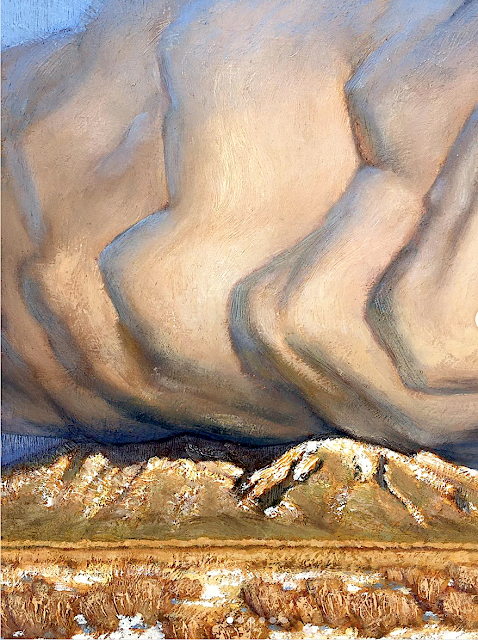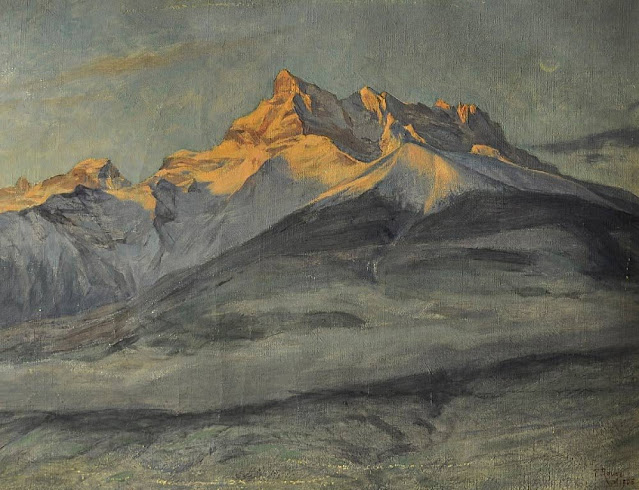JEAN -BAPTISTE NÉE (b.1986)
Le Grand Veymont (2,341m - 7,680 ft)
France (Vercors)
In Vercors, hiver, paroi, gel (II), lavis, 2019, 16 x 25cm
The artist
Jean-Baptiste Née,
born in 1986. is a french painter, scenographer and visual artist,
graduated from Arts-Décoratifs of Paris in 2012. Jean-Baptiste Née works
in the mountains and high mountains, always in situ, in direct
confrontation with the movements of the earth and water and wind. He
gives a growing place for the action of the elements on the work in
progress (rain, snow, frost, etc.). He established his "large workshop"
in the Swiss Alps or in the Vercors massif - especially in winter -, as
well as during long hikes in the Italian Alps. In the winter of 2018,
he worked in the massifs of Wudangshan and Lushan, in China, and became
interested in the Taoist notion of "Sky". Since 2016, Jean-Baptiste Née
exhibits regularly in galleries in France and Switzerland. His workshop
is in Montreuil, France. Exhibited in Galerie Camera
Obscura in Paris. A book was recently published about his work "Le monde nu" Éditions Hartpon.
Contact @jeanbaptiste.nee.
Jean Basptiste Née website
Le Grand Veymont (2,341m - 7,680 ft)( is a mountain in the district of Gresse-en-Vercors, part of the department of Isère, France, is the highest point of the Massif du Vercors, but not the highest of the Vercors Regional Natural Park (which is the Rocher Rond at 2,453m). It has a prominence of 1165 metres and an isolation of 26.88 kilometres. It is situated between le Pas de la Ville to the north and le Pas des Chattons to the south, and is part of the eastern edge of the high plateau of the Massif du Vercors. It is preceded to the north by (north to south) "le Rocher de Séguret" (the Rock of Séguret, 2051 metres), "Roche Rousse" (Red Rock, 2105 metres), and "le Sommet de Pierre-Blanche" (the Summit of White Rock, 2106 metres) and followed to the south (north to south) by Petit Veymont or Aiguillette (little Veymont or small needle, 2120 metres) and Mont Aiguille (Mount Needle, 2085 metres). Due to its location in the Parc du Vercors, it is far from any paved road. A moderately easy route to the summit involves walking about 10 km, hiking through the backcountry.
On 10 February 2007, a twin-engine light aircraft flying from London to Cannes disappeared in a snowstorm over le Grand Veymont, crashing into the mountainside and killing all three people aboard. The bodies and wreckage were recovered less than 24 hours later, at around 1960 metres above sea level, close to the Pas de la Ville, after a rescue operation involving more than one hundred policemen, firemen, mountain rescue specialists, and three helicopters equipped with infra-red cameras.
-%20-%20Vercors,%20hiver,%20paroi,%20gel%20(II),%20lavis,%202019,%2016x25cm-%20Vercors,%20hiver,%20paroi,%20gel%20(II),%20lavis,%202019,%2016x25cm.png)

,%20Savie%CC%80se%20in%20Valais%20(Morning%20in%20the%20mountains),%201912.png)

-Bushveld%20%201942%20CP%20.jpg)
%20-%20The%20Anva%CC%84r-i%20Suhayli%CC%84%20or%20Lights%20of%20Canopus-%201847-The%20Walters%20Art%20Museum15.jpg)

%20-%20Mount%20Haku,%20Kaga%20Province,%20%20Woodblock%20Print,%20%201862-%20in%20Sixty-eight%20Views%20of%20the%20Various%20Provinces,%201862.jpg)
%20%20Sorrente,%20devant%20la%20mer%20de%20Naples,%201851%20Huile%20sur%20papier%20maroufle%CC%81%20sur%20toile%2024,5%20x%2033%20cm%20coll%20prive%CC%81e%20courtesy%20gaelrie%20d'Athnes%20.png)

%20alta-montagna(monte%20binaco%20detail.jpg)
-%201889%20n.jpg)

%20-Nananu,-fiji-%20watercolor%20%2028.5%20x%2042%20cm.jpg)
%20New%20Plymouth%20and%20Mt%20Taranaki:%20Egmont%20in%20background-%20ALexander%20Turnbull%20LIbrary.jpeg2.jpg)

%20The%20Dom%20and%20Ta%CC%88schhorn%20above%20Zermatt-watercolour%2030.5%20x%2037.5%20cm.%20John%20Mitchell%20Fiene%20Arts%20%20London%20.jpg)
,%201954%20oil%20on%20canvas%2088.3%20x%20129.5%20cm%20Private%20collection.jpg)